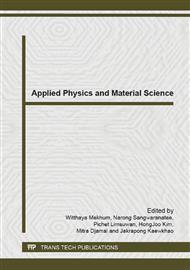p.128
p.132
p.135
p.139
p.143
p.147
p.151
p.155
p.159
Effect of Epoxide Group in Thermoplastic Elastomer on the Properties of Polyamide6 and Low-Density Polyethylene Blends
Abstract:
Studies on the effect of percentages of epoxide group in thermoplastic elastomer as a compatibilizer on properties of polyamide6 (PA6) and low-density polyethylene (LDPE) blends was successfully carried out in this study. Thermoplastic epoxidized natural rubber (TPENR), made from epoxidized natural rubber (ENR) and LDPE, prepared from 3 types of ENR, i.e., ENR-20, ENR-50 and ENR-70, with the ratio of 90/10 of LDPE/ENR by weight. TPENR was applied as a compatibilizer into the blend of PA6/LDPE/TPENR at the ratio by weight of 80/20/1 by using a twin screw extruder at 235°C. All test specimens were characterized for phase morphology, impact strength and rheological behaviour. Results exhibited that phase morphology of PA6/LDPE blend was incompatible. The addition of TPENR improved the compatibility of PA6/LDPE blends. With inclusion of TPENR-20 as a compatibilizer, the uniformity and the maximum reduction of dispersed phase sized were observed. Moreover, it was revealed that the rheological properties such as shear viscosity increased when compared with PA6/LDPE incompatible blend. In addition, it was found that the highest shear viscosity and also the highest impact strength were obtained for the blend of PA6/LDPE compatibilized by TPENR-20. This result was further supported by SEM images, which showed that the smallest dispersed phase size occurred when a TPENR-20 was used as a compatibilizer. So, it was clearly demonstrated in this study that the suitable type of TPENR, i.e., TPENR-20, has an effect on improving phase morphology and properties of PA6/LDPE blends.
Info:
Periodical:
Pages:
143-146
Citation:
Online since:
June 2014
Price:
Сopyright:
© 2014 Trans Tech Publications Ltd. All Rights Reserved
Share:
Citation:


